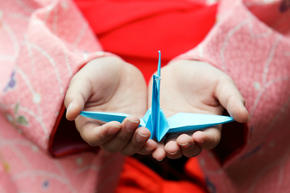
Origami is a beautiful art form that can facilitate a variety of concepts. It was first developed by the Chinese, who also happened to develop paper. It is said that traveling monks brought both the art form and the paper to Japan. It was a hit! Japanese royalty took to folding paper as an expensive hobby. They loved to create celebratory items, such as butterflies for weddings and good luck noshi for Samurai. As global travel expanded into the Far East, many treasures were brought back to Europe, including origami. Its popularity spread, and origami was even used as an educational tool at one of the first kindergartens in France. Great! So what else can you do with it? Try using it during your math lessons.
Geometry Origami Applications
Origami has been used in mathematics to demonstrate proofs of geometrical constructions from as early as 1893. Also, since 1989, the International Conference on Origami in Science, Math, and Education has been meeting with a goal of making origami a powerhouse in the world of mathematical modeling and exploration. Many of the mathematical structures and equations are beyond my personal understanding (I’m not a math teacher), but origami can be used in the classroom at any level. You can use paper folding to create crease patterns that are used to determine whether a flat folded model is possible. Geometric construction problems can also be taught using origami. For example, trisecting an arbitrary angle or doubling the cube have been proven unsolvable when using a compass and straightedge, but can be solved using basic origami folds. Even NASA has employed origami to solve real-world problems, such as the Miura Map Fold that helped engineers create a rigid fold that would enhance their ability to deploy solar panels on satellites. Before completing origami math in the classroom, it may help to view a few of the amazing professional development videos available online. They outline how to teach using origami. The Ted Talk, Robert Lang: The Math and Magic of Origami, is great places to start. According to Lang, there are four main laws of origami:
1. Two colorability: Each single sheet of origami paper needs to have two colors, one on each side.
2. Any mountain/valley fold differs by two, no more or less.
3. All alternate angles around a vertex add up (when numbered) to a straight line.
4. A sheet can never penetrate a fold, no matter how many sheets or folds you create.
These four laws govern all that is possible with this outstanding art form/teaching tool.
Elementary Origami Applications
If you are considering using origami in the lower grades, it is great for expressing a number of concepts such as: polygons (triangles, rhombus, pentagon, hexagon, octagon), angle properties (180 degrees in a triangle, trisection), polyhedra (cube, rectangular prism, tetrahedron, octagon), symmetry, powers of two, algebra, and problem solving.
I have used basic paper folding to show young and/or special needs children various shapes. One sheet of origami paper can quite easily become a triangle, rectangle, rhombus, or square. I have also used basic origami to create houses for a fact family lesson. The folding was simple and the kids loved them! Additionally, origami is a great way to practice volume and surface area problems; you can have the class fold faces, edges and vertices, or even cups and then determine area and volume. Using two-toned paper, fold a shape, then have the class determine which percent of the area shown is a given color. Origami creates creases and these creases often comprise angular geometric shapes. Have the class use their know-how to determine angles, rays, and perimeters of various creases found after opening the folded art.
I recommend scanning the web and purchasing or downloading books about origami and math. There are so many applications for using origami to demonstrate, express, and encourage mathematical concepts and reasoning. For a head-start on your next origami math lesson, follow the links that are embedded in this article. Be creative, learning can be fun!

